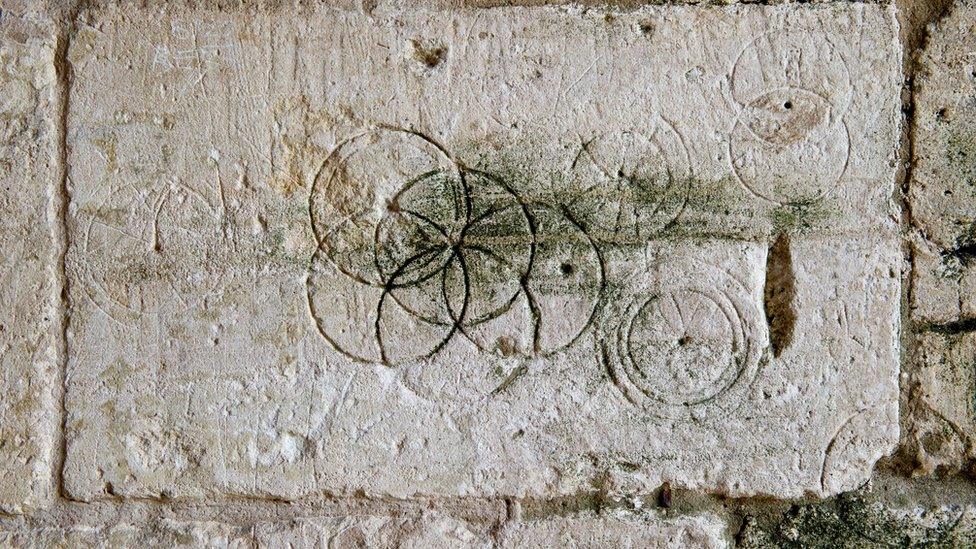Public asked to record 'witch' markings on Halloween
- Published
Watch: Witches' marks in England
Members of the public are being asked to help create a record of ritual markings on buildings that were once believed to ward off evil spirits.
The "witches' marks" were often carved near entrances to buildings, including the house where Shakespeare was born and the Tower of London.
The symbols were thought to offer protection when belief in witchcraft and the supernatural was widespread.
But heritage agency Historic England says too little is known about them.
The symbols, also known as apotropaic marks, can be found on medieval houses, churches and other buildings, most commonly from around 1550 to 1750.
They took many forms, but the most common type was the "Daisy Wheel", which looked like a flower drawn with a compass in a single endless line that was supposed to confuse and entrap evil spirits.
They also sometimes included letters, such as AM for Ave Maria, M for Mary or VV, for Virgin of Virgins, scratched into walls, engraved on wooden beams and etched into plasterwork to evoke the protective power of the Virgin Mary.

You might also like:

Known examples of witch markings include several found at Shakespeare's birthplace in Stratford-upon-Avon, Warwickshire, carved near the cellar door where beer was kept, and at the Tithe Barn, Bradford-on-Avon, Wiltshire, to protect crops.
Others have been found in caves, such as the Witches' Chimney at Wookey Hole, Somerset, which has numerous markings.

The "witches' marks" were often carved near entrances to buildings

Others were found inside buildings, such as on an oak beam at the LASSCO Three Pigeons in Oxfordshire
Duncan Wilson, chief executive of Historic England, said: "Witches' marks are a physical reminder of how our ancestors saw the world.
"They really fire the imagination and can teach us about previously-held beliefs and common rituals.
"Ritual marks were cut, scratched or carved into our ancestors' homes and churches in the hope of making the world a safer, less hostile place.
"They were such a common part of everyday life that they were unremarkable and because they are easy to overlook, the recorded evidence we hold about where they appear and what form they take is thin."

Witchcraft in England

Wookey Hole Caves near Weston-super-Mare where a large number of apotropaic marks have been found.
In 1542 Parliament passed the Witchcraft Act, external that defined witchcraft as punishable by death
The first book on the recognition and prosecution of witches was known as the Malleus Malificarum, external
Formal accusations against witches reached a peak in the mid to late 16th Century, particularly in east and south-east England. The most famous figure from this time was perhaps Matthew Hopkins who claimed to be the Witchfinder General, although the title was never made official by Parliament
The last trials were held in Leicester in 1717, but the last known execution was much earlier and took place in Devon in 1685
The witches tale, external: A heart carved into the wall of a building in Kings Lynn marketplace is believed to mark the spot where the heart of Margaret Read - a condemned witch who was burnt at the stake - leapt out of the flames and hit the wall
- Published31 October 2016
- Published25 November 2016

- Published30 October 2016

- Published28 October 2016
